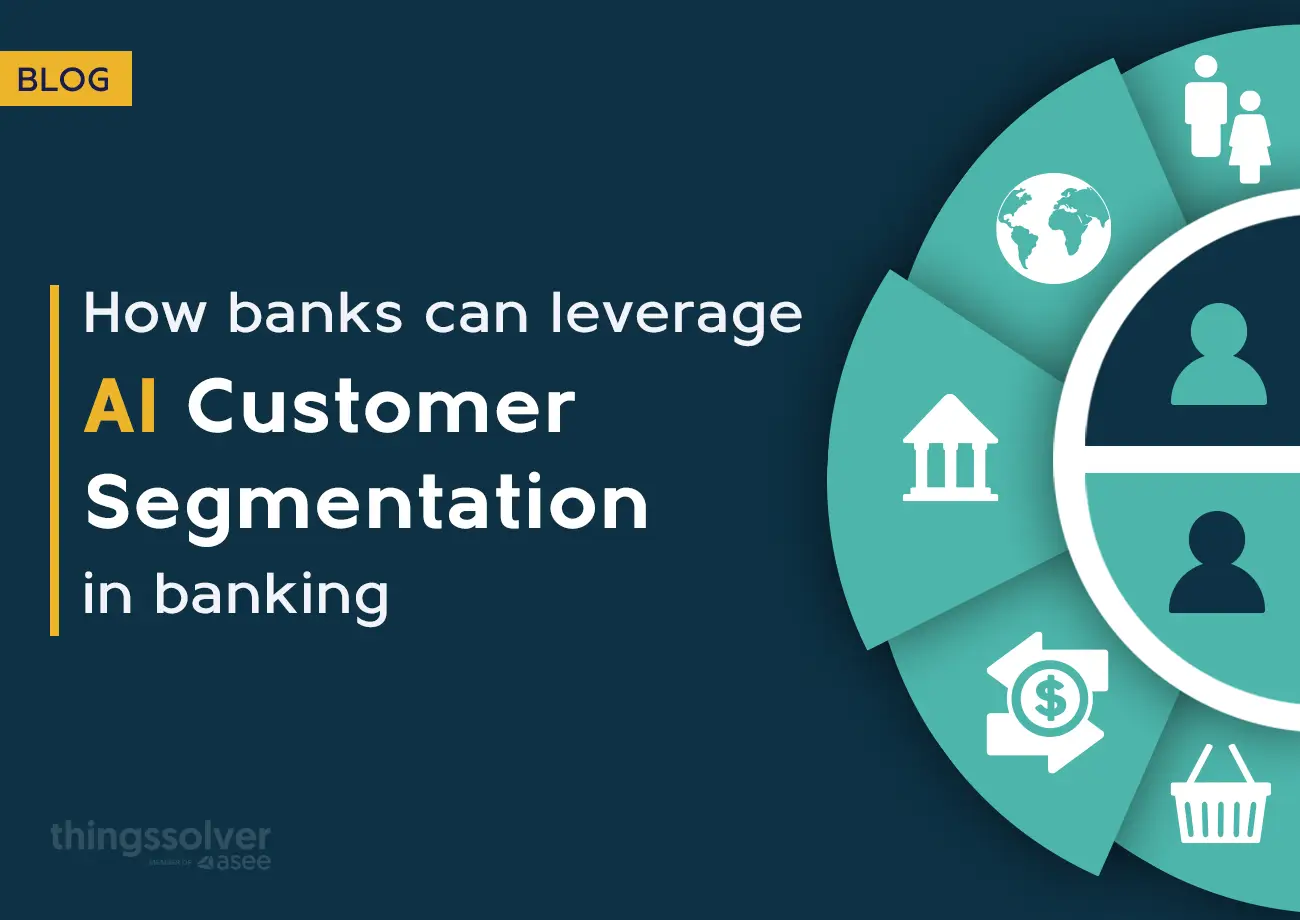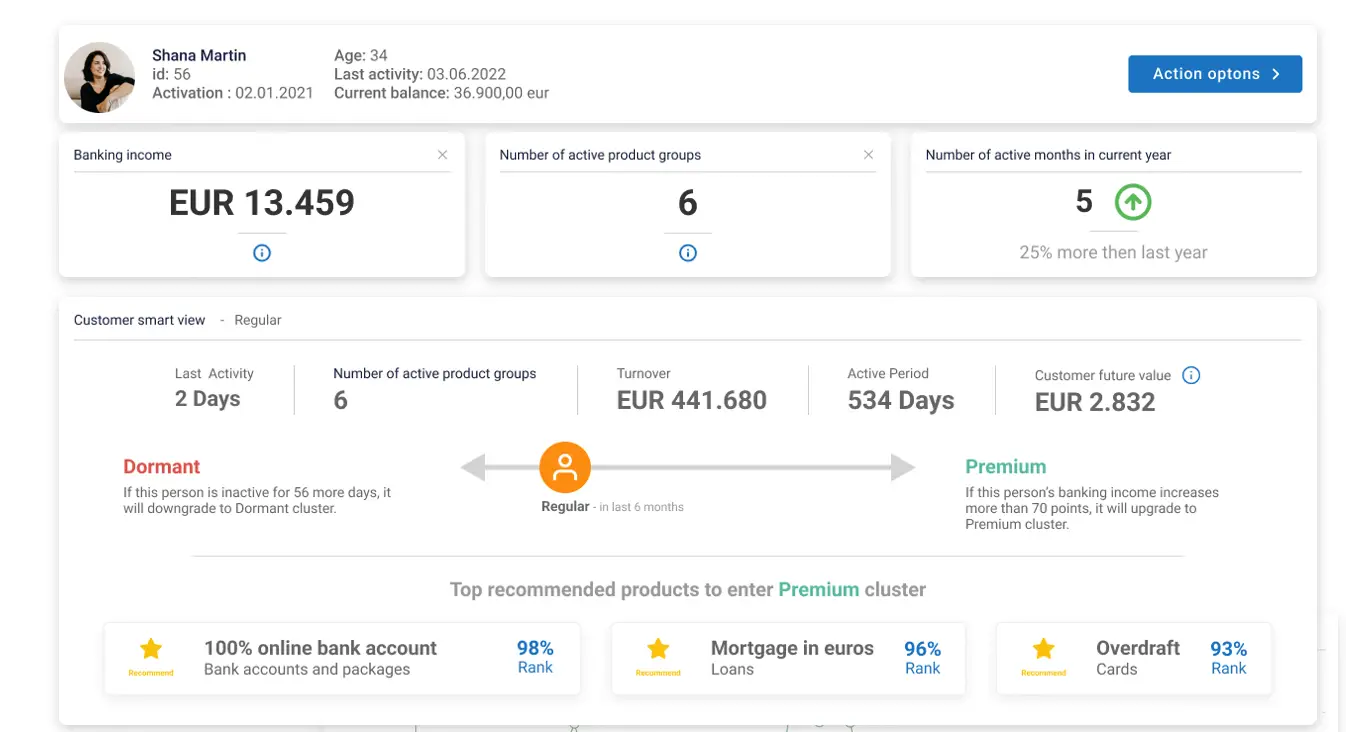How to boost online sales this holiday season with a personalized shopping experience
The holiday season is the most crucial period for retailers. Besides high sales volume, it is also an opportunity to…
Read more26. 03. 2021.

Segmentation, a method of categorizing customers based on shared traits, is a powerful tool in banking.
What makes AI customer segmentation in banking particularly appealing is the wealth and diversity of available data. Here, it’s not just about dividing customers into groups — it’s the first step in a deeper understanding of each group’s preferences and behaviors.
By unlocking insights through segmentation, banks can craft personalized marketing strategies tailored to meet each group’s unique needs.
Read on as we:
AI-driven customer segmentation is the process of categorizing a customer base into distinct groups or segments using artificial intelligence algorithms and techniques.
Unlike traditional segmentation methods that rely solely on manual analysis, AI-driven segmentation relies on machine learning, data mining, and predictive analytics to identify patterns, similarities, and differences among customers based on various attributes, behaviors, and interactions.
This approach uses advanced algorithms to analyze vast amounts of customer data, including:
AI algorithms can uncover complex relationships and hidden patterns within this data, allowing you to create more granular and accurate customer segments.
The key advantage of AI-driven customer segmentation lies in its ability to automate and refine the process continuously.
By continuously analyzing and learning from new data inputs, AI algorithms can adapt and update segmentation models, providing you with up-to-date and more precise insights into customer preferences, needs, and buying behaviors.
This, in turn, enables you to tailor marketing strategies, personalize experiences, and optimize decision-making to better serve the diverse needs of different customer segments.
As you’ve probably guessed so far, customer segmentation holds significant importance in banking. The reasons for that are diverse:
Segmentation allows banks to tailor their services, product offerings, and communication strategies to better match the diverse needs of their clients. For instance, one segment might prefer investment products, while another might prioritize savings accounts or loans.
Understanding customer segments enables banks to personalize their interactions and experiences. By knowing a customer’s segment, banks can offer targeted recommendations, customized offers, and personalized communication.
By categorizing customers based on their financial behavior and creditworthiness, banks can better evaluate risks associated with lending, reaching more accurate credit decisions and generating risk mitigation strategies.
Thanks to segment-specific marketing campaigns, banks can allocate marketing resources more efficiently. This often assumes crafting messages that resonate with each segment’s preferences and lead to higher engagement and conversion rates.
Understanding segments allows banks to identify high-value customers and develop strategies to retain them. At the same time, it helps in targeting specific segments for acquisition, focusing efforts on attracting new customers who align with the bank’s services.
Finally, segmentation can drive profitability by prioritizing high-value segments and developing services that cater specifically to their needs, leading to increased revenue opportunities.
Essentially, customer segmentation in banking is essential in many ways. But before we move on to its implementation, let’s quickly go over some of the most popular segmentation approaches.
In banking, segmentation approaches help you categorize customers based on various criteria. This, in turn, helps you better understand their behaviors, needs, and preferences.
Here are some of the most popular segmentation approaches, both traditional and AI-powered, that will help you make more informed decisions about customer segmentation practices.
Traditional segmentation methods in banking encompass various approaches to categorizing customers for tailored services and strategies. Some of them include:
In banking, AI-powered segmentation approaches can revolutionize customer categorization by leveraging advanced technology. Some of the most often AI-powered segmentation approaches include:
Let’s quickly go back to the traditional RFM approach and see how it helped us come up with the more advanced, AI-powered RFMT approach to segmentation.
RFM segmentation has long been a cornerstone in marketing and business analytics.
This method traditionally bins and ranks customers according to these features, assigning ranks from 0 to N across four or five tiers for each category. The higher the final segment rank, the more favorable the classification—a simple yet potent approach.
However, its limitations lie in fixed bins and potential rough segmentation due to slight variations in customer characteristics, which might lead to similar clients falling into different segments.
While insightful, this approach’s rigidity prompted us to think in the direction of RFMT—RFM with an added dimension: tenure (T), representing the client’s lifecycle duration.
Unlike RFM, RFMT forgoes binning and ranking, opting for clustering techniques driven by machine learning algorithms.
Within our platform, simplicity reigns supreme. All modules are easily comprehensible and usable even for non-tech users. With anonymized data, our platform autonomously conducts segmentation, minimizing manual work and client involvement.

The Segmentation Studio module within the Solver AI Suite allows tracking client transitions between segments, enabling the modeling of customer journeys and setting triggers for marketing automation. Segmentation, an integral part of our product, combines with recommender systems and customer lifetime value estimation to facilitate marketing automation through audience creation and campaigning.

The results are remarkable — targeting potentially loyal customer segments led to a 30% increase in conversion rates. Interestingly, the segment termed “champions” requires minimal targeting or discounts, indicating increased sales and reduced unnecessary costs.
This illustrates the power of AI-driven segmentation in optimizing marketing strategies and improving customer engagement in the banking sector.
As you can see, implementing AI-driven customer segmentation in banking across different sectors involves leveraging technology to enhance various aspects of customer service, risk management, and product offerings.
Here’s an overview of how AI segmentation can be implemented in retail banking, digital banking, and commercial banking:
AI-driven segmentation in retail banking focuses on personalized customer experiences.
By analyzing transactional data and customer behaviors, banks can categorize customers into segments based on spending habits, preferences, and engagement levels.
This allows for tailored product recommendations, personalized marketing campaigns, and targeted service offerings, ultimately enhancing customer satisfaction and loyalty.
With digital banking, AI-powered segmentation plays a pivotal role in optimizing user experiences across digital channels.
By leveraging machine learning algorithms, banks can analyze user interactions, preferences, and engagement patterns within digital platforms. This leads to personalized app interfaces, targeted promotions, and intuitive customer service, fostering increased digital engagement and customer retention.
Finally, AI algorithms can:
AI-driven segmentation in commercial banking centers around risk assessment and tailored financial solutions for businesses.
By analyzing transactional data, credit history, and business behavior patterns, banks can categorize commercial clients into segments based on risk profiles, creditworthiness, and financial needs.
This enables banks to offer personalized financial products, credit solutions, and risk management strategies, catering specifically to each business segment’s requirements.
In each sector, the implementation of AI-driven customer segmentation allows banks to:
In the banking sector, choosing the ideal AI-driven customer segmentation tool requires a careful evaluation of several key factors to ensure it aligns with the specific needs and goals of the institution.
Here are 8 key factors you should consider:
Ensure the tool can seamlessly integrate with the bank’s existing data infrastructure. Compatibility with various data sources, whether structured or unstructured, is crucial for comprehensive customer insights.
Look for tools that leverage advanced AI and machine learning algorithms. These should be capable of analyzing large volumes of data to:
Identify complex patterns,
Enable precise customer segmentation and predictive analytics.
The tool you choose should offer flexibility in creating customized segments tailored to the bank’s specific requirements.
In this case, you want to look for options that allow for the creation of diverse segmentations based on various parameters relevant to banking operations.
Real-time analysis capabilities are crucial in today’s dynamic banking landscape.
Make sure to choose a tool that provides real-time insights into customer behaviors, enabling timely decision-making and responsive actions.
For example, Solver AI Suite stands out with its ability to automatically update segments as customer behavior evolves. This will be more than enough for you to ensure accurate and current segmentation and reach decisions quickly and without much effort.
Moreover, it leverages AI algorithms to extract actionable insights from vast datasets. This allows banks to uncover nuanced patterns and trends within customer behavior, allowing for more precise upselling and cross-selling strategies.
A user-friendly interface is essential, especially if the tool will also be used by non-technical banking staff.
The platform should be intuitive, with clear visualizations and easily understandable reports. This will make sure that all banking professionals navigate and derive insights effortlessly.
Given the sensitivity of banking data, you should always prioritize tools that adhere to stringent security measures and compliance standards. Ensure the tool meets industry regulations and data privacy requirements to avoid any complications further down the road.
Consider the tool’s scalability to accommodate future growth and increasing data volumes. Additionally, assess the level of support and training offered by the tool’s provider to ensure smooth implementation and ongoing assistance.
Finally, evaluate how much you’ll need to invest in this tool to use it effectively.
Here, you should account for the tool’s cost to the value it provides. In other words, make sure to consider not just the initial investment but also ongoing maintenance, updates, and potential scalability costs.
By thoroughly evaluating these factors, you can make informed decisions when selecting an AI-driven customer segmentation tool that best suits your unique banking needs, fosters better customer insights, and improves operational efficiency.
AI-driven customer segmentation marks a transformative force in banking. It’s not just about dividing customers; it’s about understanding their every nuance. From retail to commercial banking, AI segmentation reshapes experiences, mitigates risks, and enhances offerings.
In a world steeped in data, we know that AI segmentation isn’t just a strategy; it’s a necessity for banks to thrive.
That’s why we’ve worked hard to develop Solver AI Suite and turn it into a robust solution for banking institutions seeking to leverage AI segmentation effectively. We believe that by embracing Solver AI Suite, banks can transform their approach to customer segmentation, enhancing their ability to deliver personalized experiences and drive business success in the ever-evolving banking landscape. It translates data into actionable insights, propelling banks towards superior customer satisfaction and unmatched operational efficiency.
If you are ready to embrace AI-driven segmentation, don’t hesitate to reach out to us! Let’s unlock the true essence of banking together — book a demo today and start understanding, engaging, and serving customers better than ever before.
The holiday season is the most crucial period for retailers. Besides high sales volume, it is also an opportunity to…
Read moreA closer look at analytics that matter You’ve trained your AI agent. It runs. It talks. It reacts. But does…
Read moreImagine having a team of top chefs, but your fridge is packed with spoiled ingredients. No matter how talented they…
Read more